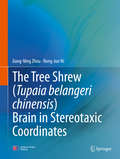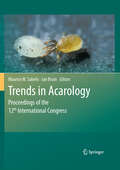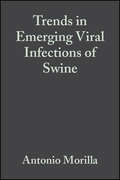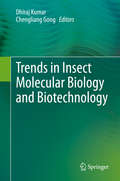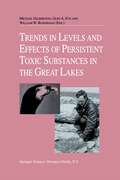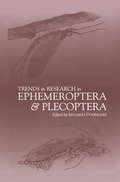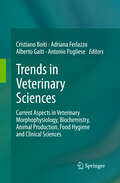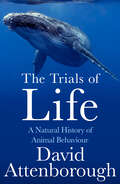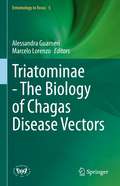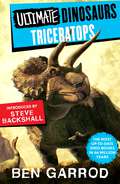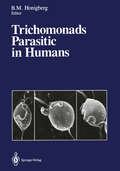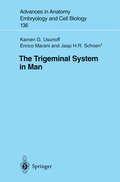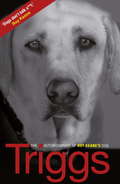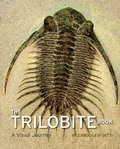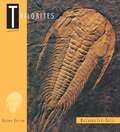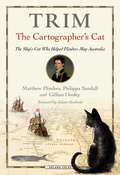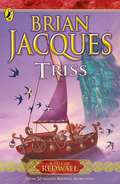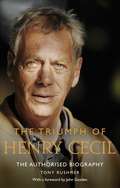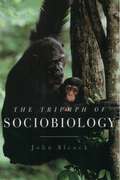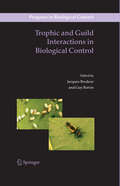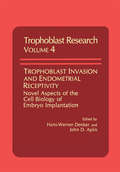- Table View
- List View
The Tree Shrew (Tupaia belangeri chinensis) Brain in Stereotaxic Coordinates
by Jiang-Ning Zhou Rong-Jun NiThis atlas is currently the most systematic and comprehensive atlas of the tree shrew brain. The purpose of this book is to help scientists acquire accurate coordinates of the brain regions of the tree shrew, which is becoming a popular animal model for a variety of human diseases. This atlas contains series of 192 coronal sections, 36 sagittal sections, and 49 horizontal sections using Nissl staining or acetylcholinesterase histochemistry as well as a series of diagrams in stereotaxic coordinates. Original photomicrographs are obtained at single-cell resolution. In addition, we also referred to magnetic resonance images acquired at 250 um intervals with a magnetic resonance scanner 9.4T. Many brain structures are first identified in tree shrews and accurately presented in a stereotaxic coordinate system. The Bregma coordinates system is used for the first time in this tree shrew brain atlas. The atlas represents the collaboration between two indispensable skills of brain research, neuroanatomy and stereotaxic surgery. It will be extensively used in neuroscience research, particularly tree shrew brain study, and will help graduate students and researchers understand brain anatomy and acquire accurate reference coordinates.
Trends in Acarology: Proceedings of the 12th International Congress
by Maurice W. Sabelis Jan BruinMites and ticks are everywhere and acarologists go after them – some explore their bewildering diversity, others try to understand their how and why. For the past 50 years, the International Congress of Acarology has been the forum for worldwide communication on the knowledge of Acari, helping researchers and students to look beyond their disciplines. Many mites and ticks are economic factors as they are pests of agricultural, veterinary and medical importance, and several species have become model organisms in modern biology. The 96 contributions to Trends in Acarology – reflecting fields as molecular biology, biochemistry, physiology, microbiology, pathology, ecology, evolutionary biology, systematic biology, soil biology, plant protection, pest control and epidemiology – have been reviewed and carefully edited. This volume contains a wealth of new information, that may stimulate research for many years to come.
Trends in Emerging Viral Infections of Swine
by Antonio Morilla Kyoung-Jin Yoon Jeffrey J. ZimmermanTrends in Emerging Viral Infections of Swine includes sections on global trade, vaccination regimens against new and emerging viruses, epidemiology and control, as well as significant new outbreaks like the West Nile virus. A contributor to Diseases of Swine, 8th edition, Dr. Zimmerman has selected three additional editors with international expertise.
Trends in Insect Molecular Biology and Biotechnology
by Dhiraj Kumar Chengliang GongThis book provides an overview on the basics in insect molecular biology and presents the most recent developments in several fields such as insect genomics and proteomics, insect pathology and applications of insect derived compounds in modern research. The book aims to provide a common platform for the molecular entomologist to stimulate further research in insect molecular biology and biotechnology.Insects are one of the most versatile groups of the animal kingdom. Due to their large population sizes and adaptability since long they attract researchers’ interest as efficient resource for agricultural and biotechnological purposes. Several economically important insects such as Silkworms, Honey Bee, Lac and Drosophila or Termites were established as invertebrate model organisms. Starting with the era of genetic engineering, a broad range of molecular and genetic tools have been developed to study the molecular biology of these insects in detail and thus opened up a new horizon for multidisciplinary research. Nowadays, insect derived products are widely used in biomedical and biotechnology industries. The book targets researchers from both academia and industry, professors and graduate students working in molecular biology, biotechnology and entomology.
Trends in Levels and Effects of Persistent Toxic Substances in the Great Lakes: Articles from the Workshop on Environmental Results, hosted in Windsor, Ontario, by the Great Lakes Science Advisory Board of the International Joint Commission, September 12 and 13, 1996
by William W. Bowerman Glen A. Fox MichaelGilbertson`Are the Great Lakes getting better or worse?' This is the question that the public, scientists and managers are asking the International Joint Commission after a quarter-century of cooperative action by the United States and Canadian governments to clean up the Great Lakes. This volume contains papers from the workshop on Environmental Results, hosted in Windsor, Ontario, by the Great Lakes Science Advisory Board of the International Joint Commission, on September 12 and 13, 1996. The Great Lakes have been through almost a century of severe pollution from the manufacture, use and disposal of chemicals. In the 1960s wildlife biologists started to investigate the outbreaks of reproductive failure in fish-eating birds and ranch mink and to link these to exposure to organochlorine compounds. Human health researchers in the 1980s and 1990s linked growth retardation, behavioral anomalies and deficits in cognitive development with maternal consumption of Great Lakes fish prior to pregnancy. The Great Lakes became the laboratory where the theory of endocrine disruptors was first formulated. Now a group of Great Lakes scientists, hosted by the International Joint Commission, has compiled the story of the trends in the concentrations and effects of persistent toxic substances on wildlife and humans. The technical papers review the suitability of various organisms as indicators, and present the results of long-term monitoring of the concentrations and of the incidence of effects. The evidence shows that there was an enormous improvement in the late 1970s, but that in the late 1990s there are still concentrations of some persistent toxic substances that have stubbornly remained at levels that continue to cause toxicological effects.
Trends in Veterinary Sciences: Current Aspects in Veterinary Morphophysiology, Biochemistry, Animal Production, Food Hygiene and Clinical Sciences
by Cristiano Boiti, Adriana Ferlazzo, Alberto Gaiti and Antonio PuglieseVeterinary science is continuously achieving important developments in all its fields as a result of continuous technological advances in diagnostic tools and applied biology. This book contains 33 papers that were selected from those presented at the 65th Congress of the Italian Society for Veterinary Sciences held at Tropea-Drapia in 2011. It provides a timely overview of the current progress being made by Italian researchers and is of great value to anyone interested in all fields of veterinary science, both theoretical and applied, ranging from animal health and care to animal production and food hygiene.
The Trials of Life: A Natural History Of Animal Behaviour
by David AttenboroughThe third and final updated edition of David Attenborough’s classic Life trilogy. Life on Earth covered evolution, Living Planet , ecology, and now The Trials of Life tackles ethology, the study of how animals behave.
Triatominae - The Biology of Chagas Disease Vectors (Entomology in Focus #5)
by Alessandra Guarneri Marcelo LorenzoThis book aims to present updated knowledge on various aspects of the natural history, biology, and impact of triatomines to all interested readers. Each chapter will be written by authorities in the respective field, covering topics such as behavior, neurophysiology, immunology, ecology, and evolution. The contents will consider scientific, as well as innovative perspectives, on the problems related to the role of triatomine bugs as parasite vectors affecting millions in the Latin American region.
Triceratops (Ultimate Dinosaurs #3)
by Ben GarrodDid Triceratops have huge, inflatable nose balloons? Was it smaller or larger than an elephant? And did it have a beak or teeth or BOTH? Quench your thirst for dino knowledge with the Ultimate Dinosaur series!Pop a dinosaur in your pocket! Introductions from Chris Packham, Steve Backshall and Dr Jane Goodall. These are the most up-to-date dino books in 66 million years, also available in audio download!TV scientist, Professor Ben Garrod, is proud to be a geek as he mixes top level science and humour to prove that science is for everyone. Looking at the evolutionary arms race, prey, predators, place, time, groups and species, Ben reveals new-look dinosaurs. Additional sections include: Ask an Expert, New Science and Fossil Finder as well as quizzes to test your dinosaur knowledge.
The Trigeminal System in Man (Advances in Anatomy, Embryology and Cell Biology #136)
by Kamen G. Usunoff Enrico Marani Jaap H.R. SchoenThis monograph offers a comprehensive review of present knowledge of the structure and connections of the trigeminal nuclei in humans, and compares it to laboratory animal findings. The authors provide cytoarchitectural data from their own research, and trace trigeminal pathways in human material by means of the Nauta technique. In humans the trigeminal nuclear complex includes the motor nucleus, the principal sensory (pontine) nucleus, the spinal nucleus (subdivided into oral, interpolar and caudal nuclei), and the mesencephalic nucleus and several small nuclei. The supratrigeminal nucleus, as described in various mammals, is not defined in the human brain. The primary afferents to all subdivisions of the trigeminal nuclear complex in humans appear to be entirely ipsilateral. Some of the 'extratrigeminal' primary afferents described in experimental animals are also present in the human brain and the nucleus ovalis receives primary and possibly secondary afferents from the trigeminal systems. A significant difference between the human trigeminal system and the subprimate species is seen in the monosynaptic cortical projection to the motor trigeminal nucleus.
Triggs: The Autobiography of Roy Keane's Dog
by TriggsThe explosive, no-holds-barred autobiography of Triggs, Roy Keane's confidant, adviser...and dog!Ten major trophies. A missed Champions League final. Player of the Year awards. Alf-Inge Haaland. Drunken nights. Contract negotiations. Patrick Vieira. Prawn sandwiches. The explosive end to Roy's relationship with Ireland and Manchester United. Triggs - TV lover, hypochondriac, noted wit, football genius and best friend to the most talked-about footballer of his generation - was witness to it all. Funny, frank and never less than 110 per cent mean-spirited, Triggs tells the truth about what it was like to be a central player in the extraordinary drama of her master's life.
The Trilobite Book: A Visual Journey
by Riccardo Levi-SettiDistant relatives of modern lobsters, horseshoe crabs, and spiders, trilobites swam the planet’s prehistoric seas for 300 million years, from the Lower Cambrian to the end of the Permian eras—and they did so very capably. Trilobite fossils have been unearthed on every continent, with more than 20,000 species identified by science. One of the most arresting animals of our pre-dinosaur world, trilobites are also favorites among the fossil collectors of today, their crystalline eyes often the catalyst for a lifetime of paleontological devotion. And there is no collector more devoted—or more venerated—than Riccardo Levi-Setti. With The Trilobite Book, a much anticipated follow-up to his classic Trilobites, Levi-Setti brings us a glorious and revealing guide to these surreal arthropods of ancient Earth. Featuring specimens from Bohemia to Newfoundland, California to the Tucson Gem and Mineral Show, and Wales to the Anti-Atlas Mountains of Morocco, Levi-Setti’s magnificent book reanimates these “butterflies of the seas” in 235 astonishing full-color photographs. All original, Levi-Setti’s images serve as the jumping-off point for tales of his global quests in search of these highly sought-after fossils; for discussions of their mineralogical origins, as revealed by their color; and for unraveling the role of the now-extinct trilobites in our planetary history. Sure to enthrall paleontologists with its scientific insights and amateur enthusiasts with its beautiful and informative images, The Trilobite Book combines the best of science, technology, aesthetics, and personal adventure. It will inspire new collectors for eras to come.
The Trilobite Book: A Visual Journey
by Riccardo Levi-SettiDistant relatives of modern lobsters, horseshoe crabs, and spiders, trilobites swam the planet’s prehistoric seas for 300 million years, from the Lower Cambrian to the end of the Permian eras—and they did so very capably. Trilobite fossils have been unearthed on every continent, with more than 20,000 species identified by science. One of the most arresting animals of our pre-dinosaur world, trilobites are also favorites among the fossil collectors of today, their crystalline eyes often the catalyst for a lifetime of paleontological devotion. And there is no collector more devoted—or more venerated—than Riccardo Levi-Setti. With The Trilobite Book, a much anticipated follow-up to his classic Trilobites, Levi-Setti brings us a glorious and revealing guide to these surreal arthropods of ancient Earth. Featuring specimens from Bohemia to Newfoundland, California to the Tucson Gem and Mineral Show, and Wales to the Anti-Atlas Mountains of Morocco, Levi-Setti’s magnificent book reanimates these “butterflies of the seas” in 235 astonishing full-color photographs. All original, Levi-Setti’s images serve as the jumping-off point for tales of his global quests in search of these highly sought-after fossils; for discussions of their mineralogical origins, as revealed by their color; and for unraveling the role of the now-extinct trilobites in our planetary history. Sure to enthrall paleontologists with its scientific insights and amateur enthusiasts with its beautiful and informative images, The Trilobite Book combines the best of science, technology, aesthetics, and personal adventure. It will inspire new collectors for eras to come.
The Trilobite Book: A Visual Journey
by Riccardo Levi-SettiDistant relatives of modern lobsters, horseshoe crabs, and spiders, trilobites swam the planet’s prehistoric seas for 300 million years, from the Lower Cambrian to the end of the Permian eras—and they did so very capably. Trilobite fossils have been unearthed on every continent, with more than 20,000 species identified by science. One of the most arresting animals of our pre-dinosaur world, trilobites are also favorites among the fossil collectors of today, their crystalline eyes often the catalyst for a lifetime of paleontological devotion. And there is no collector more devoted—or more venerated—than Riccardo Levi-Setti. With The Trilobite Book, a much anticipated follow-up to his classic Trilobites, Levi-Setti brings us a glorious and revealing guide to these surreal arthropods of ancient Earth. Featuring specimens from Bohemia to Newfoundland, California to the Tucson Gem and Mineral Show, and Wales to the Anti-Atlas Mountains of Morocco, Levi-Setti’s magnificent book reanimates these “butterflies of the seas” in 235 astonishing full-color photographs. All original, Levi-Setti’s images serve as the jumping-off point for tales of his global quests in search of these highly sought-after fossils; for discussions of their mineralogical origins, as revealed by their color; and for unraveling the role of the now-extinct trilobites in our planetary history. Sure to enthrall paleontologists with its scientific insights and amateur enthusiasts with its beautiful and informative images, The Trilobite Book combines the best of science, technology, aesthetics, and personal adventure. It will inspire new collectors for eras to come.
The Trilobite Book: A Visual Journey
by Riccardo Levi-SettiDistant relatives of modern lobsters, horseshoe crabs, and spiders, trilobites swam the planet’s prehistoric seas for 300 million years, from the Lower Cambrian to the end of the Permian eras—and they did so very capably. Trilobite fossils have been unearthed on every continent, with more than 20,000 species identified by science. One of the most arresting animals of our pre-dinosaur world, trilobites are also favorites among the fossil collectors of today, their crystalline eyes often the catalyst for a lifetime of paleontological devotion. And there is no collector more devoted—or more venerated—than Riccardo Levi-Setti. With The Trilobite Book, a much anticipated follow-up to his classic Trilobites, Levi-Setti brings us a glorious and revealing guide to these surreal arthropods of ancient Earth. Featuring specimens from Bohemia to Newfoundland, California to the Tucson Gem and Mineral Show, and Wales to the Anti-Atlas Mountains of Morocco, Levi-Setti’s magnificent book reanimates these “butterflies of the seas” in 235 astonishing full-color photographs. All original, Levi-Setti’s images serve as the jumping-off point for tales of his global quests in search of these highly sought-after fossils; for discussions of their mineralogical origins, as revealed by their color; and for unraveling the role of the now-extinct trilobites in our planetary history. Sure to enthrall paleontologists with its scientific insights and amateur enthusiasts with its beautiful and informative images, The Trilobite Book combines the best of science, technology, aesthetics, and personal adventure. It will inspire new collectors for eras to come.
Trilobites: A Visual Journey
by Riccardo Levi-SettiLong before dinosaurs roamed the earth, there were trilobites—one of the most striking animals to populate prehistoric seas and whose fossils are favorites among collectors today. From the giant trilobites of Newfoundland to fascinating new specimens from Morocco, Levi-Setti's magnificent book brings these "butterflies of the sea" to life for everyone curious about our remote past This second edition features coverage of a greater variety of trilobites, an improved photographic atlas reorganized to present their evolutionary progression, and over 200 photographs.
Trim, The Cartographer's Cat: The ship's cat who helped Flinders map Australia
by Matthew Flinders Gillian Dooley Philippa SandallNot many ships' cats have even one memorial statue, let alone six. But Trim does, including one outside Euston Station in London, proudly unveiled by Prince William on the bicentenary of Matthew Flinders's death – 19 July 2014. Trim was the ship's cat who accompanied Matthew Flinders on his voyages to circumnavigate and map the coastline of Australia from 1801 to 1803. He lived quite the adventurous life. As a small kitten he fell overboard while at sea but managed to swim back to the vessel and climb back on board by scaling a rope. This cemented his position as Flinders's beloved companion, and together they survived a Pacific voyage, the circumnavigation of Australia and a shipwreck. When Flinders was imprisoned by the French in Mauritius in 1803 Trim shared his captivity until one day he mysteriously disappeared – which heartbreakingly Flinders attributed to his being stolen and eaten by a hungry slave.Trim, The Cartographer's Cat is an ode to this much-loved ship's cat, which will warm the heart of any cat lover. The first part of the book reproduces Flinders' own whimsical tribute to Trim, written while in captivity in the early 1800s, with added 'friendly footnotes' to provide some background to Flinders's numerous literary allusions and nautical terms. Next the book discusses where Flinders was when he wrote his tribute and why, and what his letters and journals from that time tell us about his 'sporting, affectionate and useful companion'. Finally, we learn what Trim's views on all of this might have been, in a fun and fanciful observation on his premature epitaph. Accompanying all of this are beautiful maps, historical photographs, quirky original illustrations by illustrator Ad Long and excerpts from Flinders' original script, showing his beautiful handwriting. This book will make a unique and treasured gift for Flinders fans, Trim fans and cat lovers around the world.
Trim, The Cartographer's Cat: The ship's cat who helped Flinders map Australia
by Matthew Flinders Gillian Dooley Philippa SandallNot many ships' cats have even one memorial statue, let alone six. But Trim does, including one outside Euston Station in London, proudly unveiled by Prince William on the bicentenary of Matthew Flinders's death – 19 July 2014. Trim was the ship's cat who accompanied Matthew Flinders on his voyages to circumnavigate and map the coastline of Australia from 1801 to 1803. He lived quite the adventurous life. As a small kitten he fell overboard while at sea but managed to swim back to the vessel and climb back on board by scaling a rope. This cemented his position as Flinders's beloved companion, and together they survived a Pacific voyage, the circumnavigation of Australia and a shipwreck. When Flinders was imprisoned by the French in Mauritius in 1803 Trim shared his captivity until one day he mysteriously disappeared – which heartbreakingly Flinders attributed to his being stolen and eaten by a hungry slave.Trim, The Cartographer's Cat is an ode to this much-loved ship's cat, which will warm the heart of any cat lover. The first part of the book reproduces Flinders' own whimsical tribute to Trim, written while in captivity in the early 1800s, with added 'friendly footnotes' to provide some background to Flinders's numerous literary allusions and nautical terms. Next the book discusses where Flinders was when he wrote his tribute and why, and what his letters and journals from that time tell us about his 'sporting, affectionate and useful companion'. Finally, we learn what Trim's views on all of this might have been, in a fun and fanciful observation on his premature epitaph. Accompanying all of this are beautiful maps, historical photographs, quirky original illustrations by illustrator Ad Long and excerpts from Flinders' original script, showing his beautiful handwriting. This book will make a unique and treasured gift for Flinders fans, Trim fans and cat lovers around the world.
Triss (Redwall)
by Brian JacquesThe fifteenth book in the beloved, bestselling Redwall saga - soon to be a major Netflix movie!Triss is a brave squirrelmaid - enslaved by the evil ferret King Agarnu of Riftgard and his cruel daughter, Kurna. But, secretly, Triss is planning a daring escape by sea . . .As Triss sets sail, three young friends leave Salamandastron in search of adventure - and two youngsters go missing in Mossflower Woods. After three dangerous journeys, the travellers' paths cross at the famous Redwall Abbey - where Triss will discover her destiny, and a new champion will rise to carry the legendary sword of Martin the Warrior and fight for the future of Redwall . . .
The Triumph of Henry Cecil: The Authorised Biography
by Tony Rushmer'A wonderfully insightful, detailed and emotional biography of the legendary trainer's later years' Racing Post'[Cecil's] is a remarkable story and it has now been told with compassion, love, honesty and wonderful insight by Tony Rushmer' David Walsh, Sunday TimesWith a foreword by John GosdenWhen Henry Cecil sent out just 12 winners in 2005 it seemed as if the 10-time champion racehorse trainer's career was in terminal decline. The masterly touch that he'd shown through the glory-days of the two previous decades appeared to have deserted him after a series of painful professional and personal blows, including the death of his twin brother David. When Cecil was diagnosed with cancer in June 2006, it would have been enough to break many a man. But behind the scenes, the master of Warren Place in Newmarket was determined not to be labelled - in his words - a 'has-been'. Showing an iron resolve to fight for his professional reputation as well as his life, Cecil staged one of the great sporting comebacks. It was a story that captured the imagination of the racing public and beyond, peaking with his supreme handling of the unbeaten champion Frankel. Cecil's astonishing revival was witnessed in close-up by Tony Rushmer. The sports journalist became a trusted stable insider after being engaged in spring 2006 to help with the trainer's website and PR. He would remain part of the team right up until Cecil died in June 2013. Rushmer's unique access over seven years - in which he saw Cecil at the best and worst of times - allows him to provide a fresh perspective on an incredible part of the trainer's career. He is helped by many of those who were closest to the story, having interviewed numerous people during his extensive research. Containing fascinating detail and a wealth of new material, The Triumph of Henry Cecil shows how Cecil emerged from his slump, displayed relentless strength in the face of a cruel disease and trained the magnificent Frankel - as brilliant a racehorse as the sport has ever known.
The Triumph of Sociobiology
by John AlcockIn The Triumph of Sociobiology, John Alcock reviews the controversy that has surrounded evolutionary studies of human social behavior following the 1975 publication of E.O. Wilson's classic, Sociobiology, The New Synthesis. Denounced vehemently as an "ideology" that has justified social evils and inequalities, sociobiology has survived the assault. Twenty-five years after the field was named by Wilson, the approach he championed has successfully demonstrated its value in the study of animal behavior, including the behavior of our own species. Yet, misconceptions remain--to our disadvantage. In this straight-forward, objective approach to the sociobiology debate, noted animal behaviorist John Alcock illuminates how sociobiologists study behavior in all species. He confronts the chief scientific and ideological objections head on, with a compelling analysis of case histories that involve such topics as sexual jealousy, beauty, gender difference, parent-offspring relations, and rape. In so doing, he shows that sociobiology provides the most satisfactory scientific analysis of social behavior available today. Alcock challenges the notion that sociobiology depends on genetic determinism while showing the shortcoming of competing approaches that rely on cultural or environmental determinism. He also presents the practical applications of sociobiology and the progress sociobiological research has made in the search for a more complete understanding of human activities. His reminder that "natural" behavior is not "moral" behavior should quiet opponents fearing misapplication of evolutionary theory to our species. The key misconceptions about this evolutionary field are dissected one by one as the author shows why sociobiologists have had so much success in explaining the puzzling and fascinating social behavior of nonhuman animals and humans alike.
Trophic and Guild Interactions in Biological Control (Progress in Biological Control #3)
by Jacques Brodeur Guy BoivinThis volume explores modern concepts of trophic and guild interactions among natural enemies in natural and agricultural ecosystems - a field that has become a hot topic in ecology and biological control over the past decade. It is the first book on trophic and guild interactions to make the link to biological control, and is compiled by internationally recognized scientists who have combined their expertise.
Trophoblast Invasion and Endometrial Receptivity: Novel Aspects of the Cell Biology of Embryo Implantation (Trophoblast Research #4)
by John D. Aplin Hans-Werner DenkerInterest in mechanisms of embryo implantation is increasing, particularly with the realization that failure of implantation after in vitro fertilization and embryo transfer places significant limits on the success of treatment. In addition, there is a need to provide hypotheses, and ultimately mechanisms, for the high rates of embryonic loss in women in the population at large. Traditionally, implantation research has concentrated on genetics and endocrinology without providing many therapeutic benefits. A new era is now beginning with the application of modem cellular and molecular approaches to the investigation of the relationship between trophoblast and endometrium. At the same time, older data can be reevaluated in the light of current research into cell cell and cell-matrix interactions. The feeling that new avenues of research are open was apparent when an international group of scientists came together at a workshop on "The Cell Biology of Trophoblast Invasion In Vivo and In Vitro" held during the XXIV Annual Meeting of the Cell, Tissue and Organ Culture Study Group (C.T.O.C.) at Heidelberg in 1986. What was unusual about this Conference was the interdisciplinary dialogue between implantation researchers and tumor biologists, highlighting aspects common to invasion of trophoblast and tumor cells.
